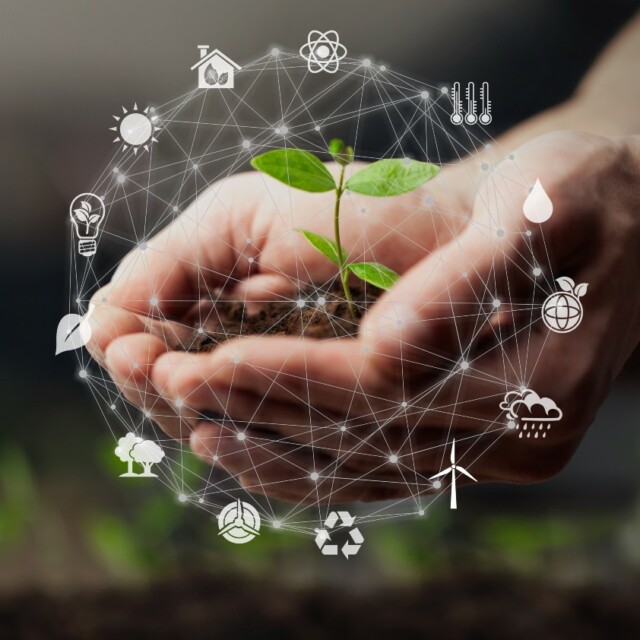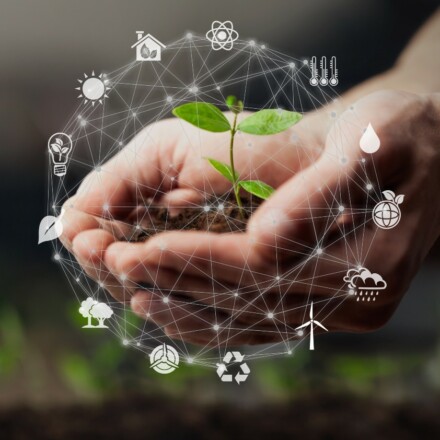In 2021, humans spewed 36.3 gigatons of carbon dioxide into the air from energy combustion and industrial processes alone. Carbon dioxide is responsible for almost two-thirds of global heating, and it also acidifies the ocean. But what if we viewed all that CO2 not as a dangerous pollutant but rather a valuable resource that’s going to waste?
That’s the idea behind ECOSynBio, a program launched by the Advanced Research Projects Agency–Energy (ARPA-E), a U.S. government agency focused on advanced energy technologies. In 2021, ECOSynBio invested $35 million in synthetic biology research that captures CO2 and, rather than simply sequestering it, turns it into chemicals that can be used for plastics, cosmetics, fuel or industrial processes.

Carbon is an essential element of chemicals that go into pharmaceuticals, plastics, food and fuel. Today, it mostly comes from nonrenewable petrochemical sources. But startups and research labs want to pull it out of the air instead of the ground.
The goal of ECOSynBio is to foster the creation of renewable fuels or chemicals that are carbon-neutral or, even better, that use carbon that would otherwise be emitted into the air.
For example, while ethanol itself burns relatively cleanly, its production adds greenhouse gas emissions. ARPA-E says that either preventing the loss of carbon as CO2 during bioconversion or incorporating external CO2 into the process would increase the amount of energy produced by more than 50%.
A new carbon economy
Dr. David Babson, director of ECOSynBio, says we’re on the cusp of a new carbon economy.
“It’s a paradigm shift,” Babson says. “Once you have that carbon source concentrated, the value of maximizing the amount that finds its way into valuable products is greater than the potential price of using more energy. This could have profound implications for the economy and the prospects for addressing climate change.”
Two of the 14 grantees illustrate the potential for turning carbon emissions into cash.
A team at the University of Washington’s Center for Synthetic Biology received $1.7 million to convert waste CO2 into malic acid, a precursor to a variety of chemicals that can be used to make plastics, detergents, pharmaceuticals and insecticides. Industrial malic acid production uses fossil fuels and emits CO2.
Once you have that carbon source concentrated, the value of maximizing the amount that finds its way into valuable products is greater than the potential price of using more energy. This could have profound implications for the economy and the prospects for addressing climate change.
—Dr. David Babson, director of ECOSynBio
The UW team will use what’s known as a cell-free process. That is, instead of engineering e. coli bacteria to produce the desired molecule and then growing the bacteria in vats, the team removes most of the cellular structures that support life, leaving only the parts needed to create chemical reactions.
Says James M. Carothers, co-director of the center, “Most of what a cell does doesn’t have anything to do with what we want to do. Let’s strip away all the things that are in a cell that we don’t want and retain the parts we do want.”
When the project reaches the production stage, the plan is to attach the bioreactor system to an industrial system and capture its emissions to produce the malic acid. UW’s process aims to recycle the carbon dioxide back into the system.
This same system could be engineered to produce other chemicals, according to Carothers.
He says, “We’re designing it to make valuable chemicals. Sequestering carbon is almost icing on the cake.”
Waste no more
LanzaTech, founded in 2005, has been feeding carbon to hungry microbes since 2005. It received $4.16 million to work with the University of Michigan and Oak Ridge National Laboratory to enhance the carbon efficiency of its existing process by developing a system that uses renewable hydrogen to fix CO2 directly into ethanol at 100% efficiency.
LanzaTech’s microbes take CO2 and ferment it into ethanol, which is a precursor to many industrial chemicals, plastics, polyester yarn and surfactants. It has two commercial units in operation that make 100,000 metric tons of ethanol a year, with plans to build 14 more around the world.

One of its latest initiatives is a partnership with Bridgestone to turn old tires and post-consumer waste into ethanol. The two will also explore opportunities to turn old tires into butadiene, a key ingredient of new tires.
“It’s a carbon source that would have been discarded, and it means you are not extracting and using more fossil inputs to make new tires. Our ultimate goal is to go from end-of-use tires to new materials, including the materials to make tires. This is real circularity,” says Michael Köpke, vice president of synthetic biology at LanzaTech.
Fashion retailer Zara released two limited-edition lines of “sustainable fashion” containing polyester made from LanzaTech’s ethanol.
The two-year-old spinoff LanzaJet will produce sustainable jet fuel from alcohol at a plant in Georgia, with plans for another in Illinois in partnership with Marquis Sustainable Aviation Fuels. LanzaTech and LanzaJet aim to produce a combined 1 billion gallons of sustainable aviation fuel in the U.S. by 2030.
In addition to emissions from factory smokestacks, LanzaTech’s system can be modified to use carbon monoxide, a big source of pollution from factories, as well as hydrogen, or a mix of molecules. In fact, LanzaTech can use any kind of waste—agricultural or municipal garbage—that can be superheated and turned into gas. Outputs include not only ethanol but also acetone and isopropyl alcohol.
A multi-billion dollar industry
The ECOSynBio grantees are just part of a growing sector that’s turning carbon emissions into good stuff.
This year, Nivea launched Nivea Men Climate Care Moisturizer that contains cosmetic ethanol, an ingredient made from CO2 emissions from industrial chimneys.
Air Protein feeds engineered microbes with atmospheric carbon dioxide, as well as oxygen, nitrogen, water and minerals to produce protein flour. It then flavors, colors and shapes the protein to resemble chicken, beef, pork or seafood. The company says its process takes almost six thousand times less land than producing an equivalent amount of soy protein would.
Twelve concentrates CO2 from the air or emissions to produce chemicals that can replace petrochemicals in products. It partnered with the U.S. Air Force to produce E-Jet fuel, and it’s working with LanzaTech on transforming CO2 into polypropylene.
Says Marilene Pavane, LanzaTech’s chief scientist, “Carbon will remain an important component of chemicals for a long time. We want to transform the economy based on carbon to be more circular by reusing carbon from emissions. Carbon shouldn’t be wasted. It should be treated with the high value it has.”
Lead photo courtesy of Shutterstock

